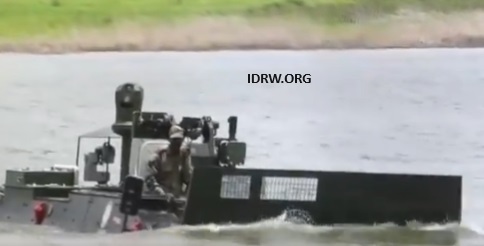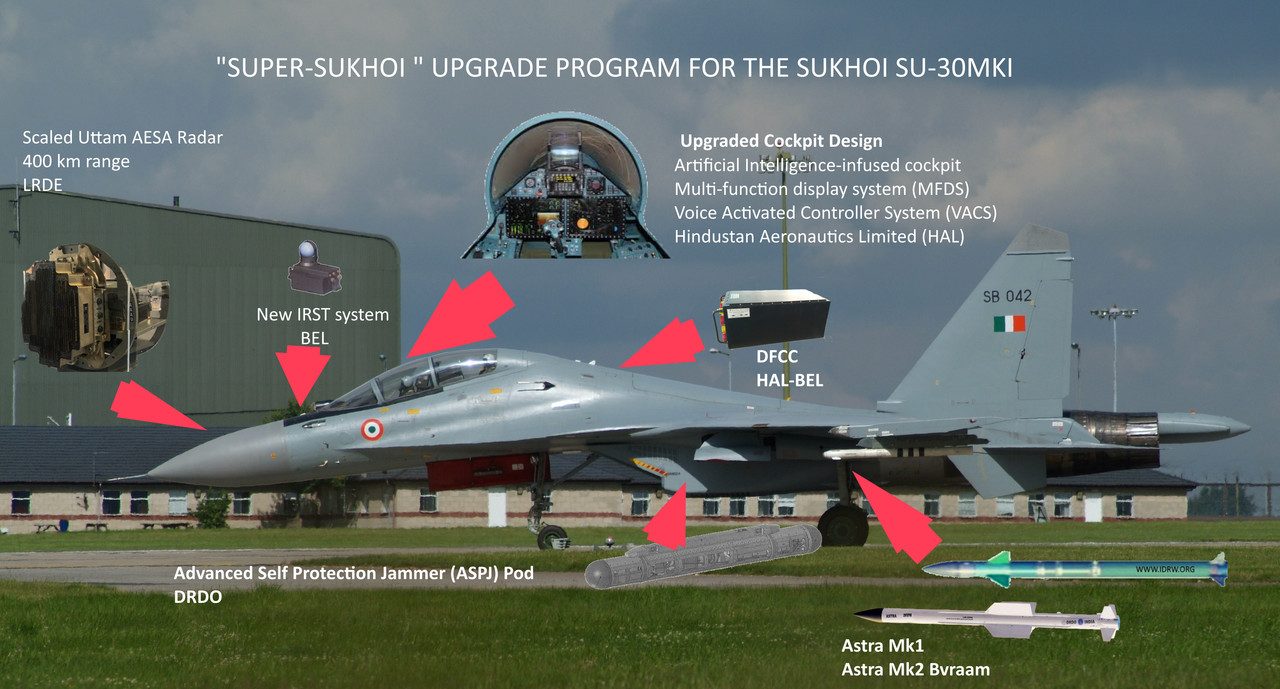SOURCE: AFI

The Defence Research and Development Organisation (DRDO)’s Vehicle Research and Development Establishment (VRDE) has successfully developed a second-generation Wheeled Armoured Platform (WhAP) specifically designed for Chemical, Biological, Radiological, and Nuclear (CBRN) operations. This cutting-edge platform boasts a range of enhancements, including amphibious capabilities, a compact design, reduced weight, optimized engine performance for high-altitude conditions, and reinforced protection measures.
The new WhAP is equipped to carry a crew of eight personnel, along with three additional members, and can be armed for combat operations. The vehicle’s amphibious nature significantly expands its operational scope, enabling it to traverse water bodies with ease. The compact design and reduced weight enhance maneuverability and transportability.
Continue readingSOURCE: AFI
The Border Security Force (BSF) has raised an alarm over the increasing sophistication of drones being used to smuggle weapons and drugs across the India-Pakistan border. According to Inspector-General of BSF (Punjab Frontier) Atul Fulzele, the newer drone models have become smaller, quieter, and capable of flying at higher altitudes, making them significantly harder to detect.
In a press briefing on Friday, Fulzele revealed that the BSF had intercepted 137 drones since January 1, seizing 28 weapons, including pistols and AK rifles, along with 160.28 kg of heroin. He emphasized that while land smuggling has become negligible, drone-based smuggling has emerged as the primary method for infiltrating contraband.
Continue readingSOURCE: AFI

In a significant gesture underscoring the deepening maritime relations between India and the United Kingdom, Admiral Sir Ben Key, First Sea Lord & Chief of Naval Staff of the Royal Navy, paid a visit to the Indian Navy’s stealth frigate, INS Tabar, during her stay in London, UK. The visit highlighted the growing cooperation and camaraderie between the two navies, which play pivotal roles in maintaining maritime security across the Indo-Pacific and beyond.
Captain MR Harish, the Commanding Officer of INS Tabar, warmly welcomed Admiral Key aboard the ship. During the visit, Captain Harish provided an extensive overview of INS Tabar’s capabilities, emphasizing the advanced technology and operational readiness that make her a formidable asset in the Indian Navy’s fleet. He also discussed the broader objectives of INS Tabar’s Operational Deployment, which aims to foster closer ties with partner navies, including the Royal Navy, through joint exercises, port visits, and professional exchanges.
Continue readingSOURCE: RAUNAK KUNDE / NEWS BEAT / IDRW.ORG

In a significant development, India has decided to reduce the number of nuclear attack submarines planned under Project 77 from three to two. This decision comes after internal discussions with the Indian Navy and is aimed at optimizing resources while maintaining the core capabilities of the submarine fleet.
Initiated in 2015, Project-77 envisioned the development and construction of six advanced nuclear attack submarines in two phases. While the design and engineering phases have been successfully completed in 2022, the project has faced budgetary constraints.
Continue readingSOURCE: RAUNAK KUNDE / NEWS BEAT / IDRW.ORG

The Indian Air Force (IAF) and Hindustan Aeronautics Limited (HAL) are forging ahead with the ‘Super Sukhoi’ upgrade program, a comprehensive modernization initiative for the IAF’s Su-30MKI fighter jets. This ambitious project promises to significantly enhance both the indigenous content of the aircraft and their overall serviceability.
The upgrade package, slated for the initial batch of 84 Su-30MKIs, is expected to propel the level of indigenous content to a noteworthy 71%. This signifies a substantial leap in India’s self-reliance in fighter jet technology. By reducing dependence on foreign sources for components and systems, the IAF will gain greater control over maintenance and upgrade cycles.
Continue readingSOURCE: RAUNAK KUNDE / NEWS BEAT / IDRW.ORG
)
The skies over India are set to witness a changing of the guard as the Indian Air Force (IAF) prepares to phase out its ageing fleet of Hawker Siddeley HS 748 Avro transport aircraft. These twin-turboprop veterans, serving the IAF since the 1960s, will gradually be replaced by the more modern and versatile Airbus C-295M transport aircraft.
The C-295M, with its faster deliveries spearheaded by Airbus Defence, is nearing the point where the trusty Avros will be deemed surplus to requirements. This transition marks a significant chapter in the evolution of the IAF’s transport capabilities.
Continue readingSOURCE: AFI

In a significant development for India’s indigenous fighter aircraft program, the Light Combat Aircraft (LCA) Mk II is set to take flight by March 2026. This timeline was confirmed during a high-level review meeting held at DRDO Bhawan, attended by top officials from the Defence Research and Development Organisation (DRDO), Aeronautical Development Agency (ADA), and the Indian Air Force (IAF).
The rollout of the LCA Mk II is scheduled for post-August 2025, followed by nearly three years of intensive developmental flight testing. The aircraft is expected to achieve Initial Operational Clearance (IOC) by the end of 2029, paving the way for production commencement in 2030 and deliveries from 2032 onwards.
Continue readingSOURCE: AFI

The Indian Air Force (IAF) is set to significantly extend the production timeline of the indigenously developed Light Combat Aircraft (LCA) Tejas Mk1A. The force plans to place orders for an additional 97 Tejas Mk1A fighter jets later this year.
This development comes after the IAF had already placed an order for 83 Tejas Mk1A jets in 2021. Without the new order, the production line was projected to conclude around 2028. However, with the upcoming larger order, the production timeline is now extended to 2032.
Continue readingSOURCE: AFI

A report by the Institute of Strategic Studies, a Pakistan-based think tank, has raised concerns over India’s growing missile defense capabilities, arguing that they pose a significant threat to regional stability and Pakistan’s nuclear deterrent.
The report highlights the deployment of India’s Phase I missile defense system along the border with Pakistan and China, equipped with the S-400 air defense system. These systems have the capacity to detect objects up to 600 kilometers within Pakistani territory. India’s ongoing development of advanced radars with extended ranges further exacerbates the situation, potentially enabling the interception of Pakistan’s Hatf, Ghauri, and Shaheen missiles.
Continue readingSOURCE: AFI
Pakistan has vehemently denied media reports alleging the supply of Shaheen-3 missiles to Iran. The denial comes amidst heightened tensions in the Middle East following the assassination of Hamas leader Ismail Haniyeh and the subsequent deployment of US naval forces to the region.
The Foreign Office spokesperson, Mumtaz Zahra Baloch, categorically dismissed the claims as baseless and false. She emphasized the importance of relying on credible sources and cautioned against the spread of misinformation, particularly in such a sensitive geopolitical climate.
Continue readingSOURCE: IDRW.ORG TEAM

Saab India has expressed its capability to meet the Indian Air Force’s (IAF) anticipated high production demands for the Gripen-E fighter jet if awarded the Medium Multi-Role Fighter Aircraft (MRFA) tender.
The Swedish aerospace giant boasts of its Linköping facility’s capacity to produce between 20 to 25 Gripen-E jets annually. This claim is significant considering the global supply chain disruptions currently affecting the aerospace industry. Saab has positioned itself as a reliable partner, assuring the IAF of its ability to deliver aircraft as per requirement.
Continue readingSOURCE: IDRW.ORG TEAM

Tardid Technologies Pvt Ltd has made significant strides in autonomous maritime technology with the launch of its A5 Meglan Autonomous Unmanned Surface Vessel (USV). Equipped with advanced AI capabilities, the A5 Meglan is poised to redefine surveillance, environmental monitoring, and maritime security.
Unlike existing remote-controlled USV systems, the A5 Meglan operates independently, thanks to its cutting-edge sensors, navigation systems, and AI algorithms. Tardid has developed a proprietary Close-In Station Keeping (CISK) and Collision Detection and Collision Avoidance (CDCA) engine, enabling the USV to navigate complex maritime environments without human intervention.
Continue readingSOURCE: AFI

In a recent address, Hindustan Aeronautics Limited (HAL) Chairman and Managing Director C B Ananthakrishnan announced a bold forecast for India’s annual arms exports, predicting a significant rise to ?50,000 crore. This projection aligns with Defence Minister Rajnath Singh’s vision for bolstering the nation’s defense capabilities and global footprint.
Ananthakrishnan emphasized the various government initiatives propelling this growth, highlighting a concerted push towards the indigenization of defense equipment. These efforts aim to curtail defense imports and reduce reliance on foreign Original Equipment Manufacturers (OEMs). In a letter, he noted, “Various initiatives of the Government of India have given thrust on the indigenization of Defence equipment, to reduce Defence imports as well as dependence on the foreign OEMs.”
Continue readingSOURCE: AFI

India, a nation with two nuclear-armed neighbors—China and Pakistan—faces persistent border disputes and geopolitical tensions. Despite these threats, India does not have a widespread system of nuclear bunkers for its civilian population. This absence raises significant questions about the country’s preparedness for potential nuclear scenarios, especially given the volatile regional dynamics.
India shares complex and often contentious relationships with both China and Pakistan. Border disputes, such as those in Ladakh with China and in Kashmir with Pakistan, have resulted in numerous skirmishes and standoffs over the years. Both neighbors possess substantial nuclear arsenals, heightening the strategic stakes and necessitating robust defense mechanisms.
Continue readingSOURCE: AFI

In a significant development, scientists from the Council of Scientific and Industrial Research (CSIR) have successfully created a battery that operates efficiently in sub-zero temperatures. This groundbreaking technology holds immense potential for both the armed forces and civilian populations residing in high-altitude regions.
The innovative battery combines a durable cathode catalyst with an anti-freezing electrolyte, making it ideal for energy solutions in remote areas where conventional batteries often falter due to extreme cold.
Continue reading